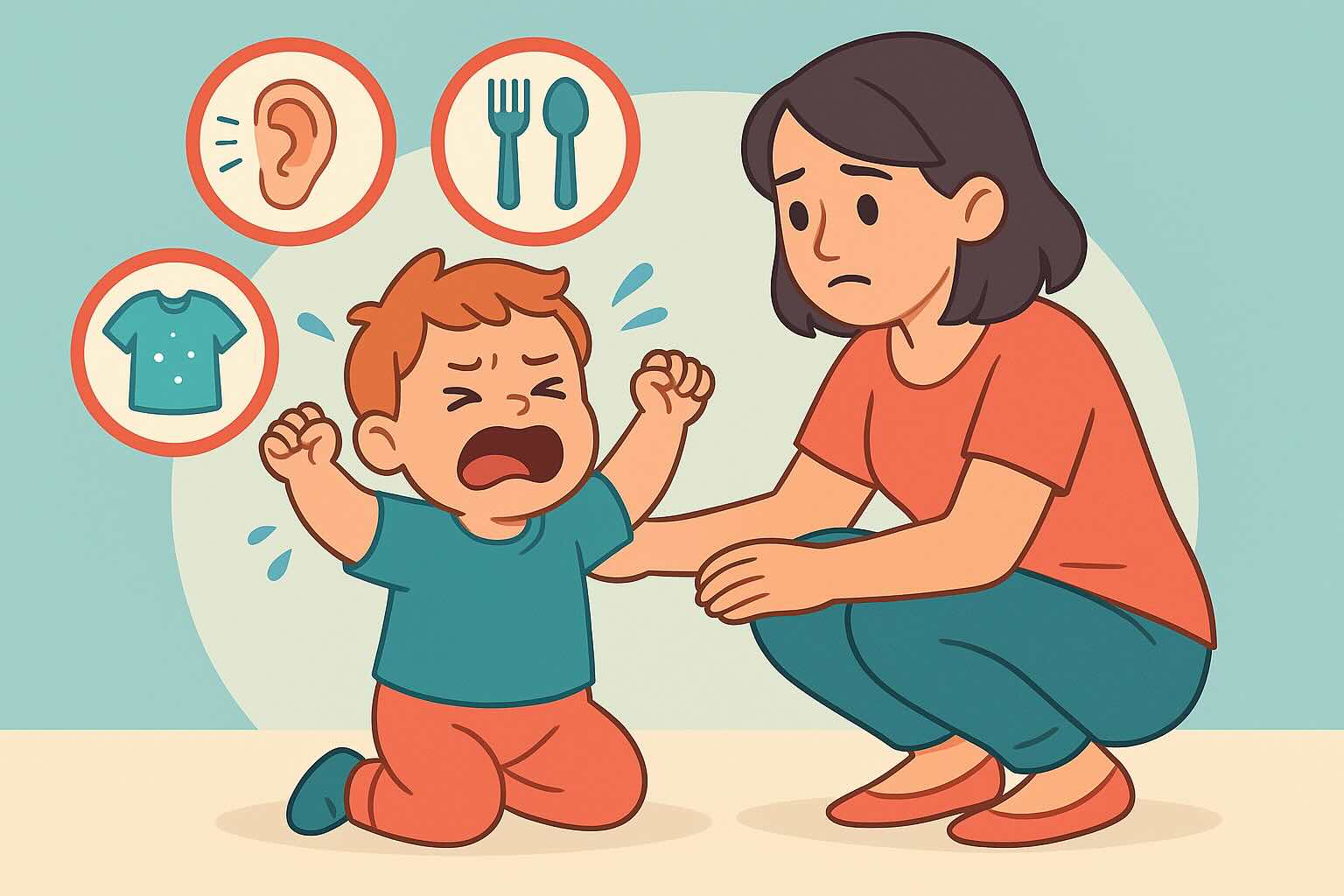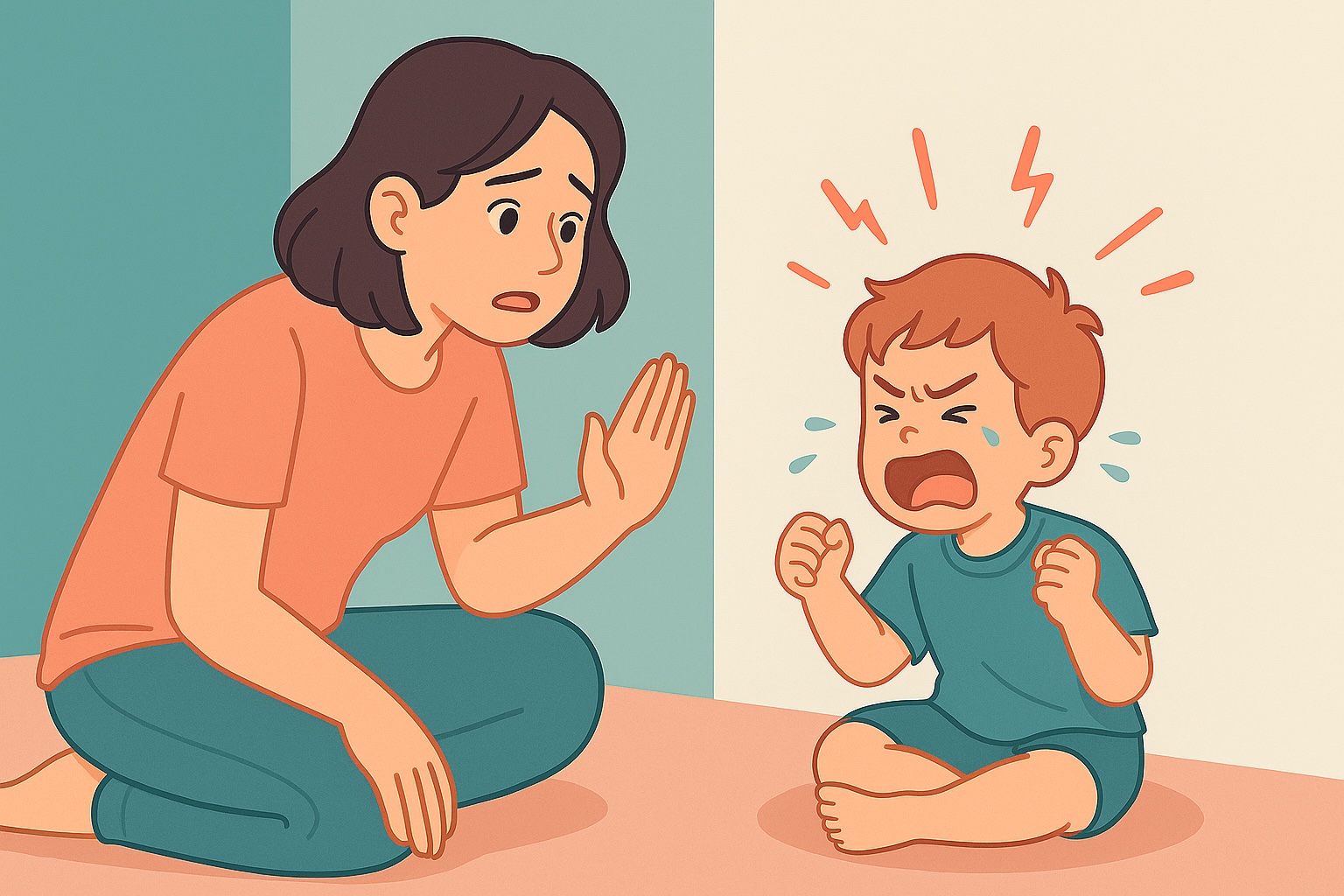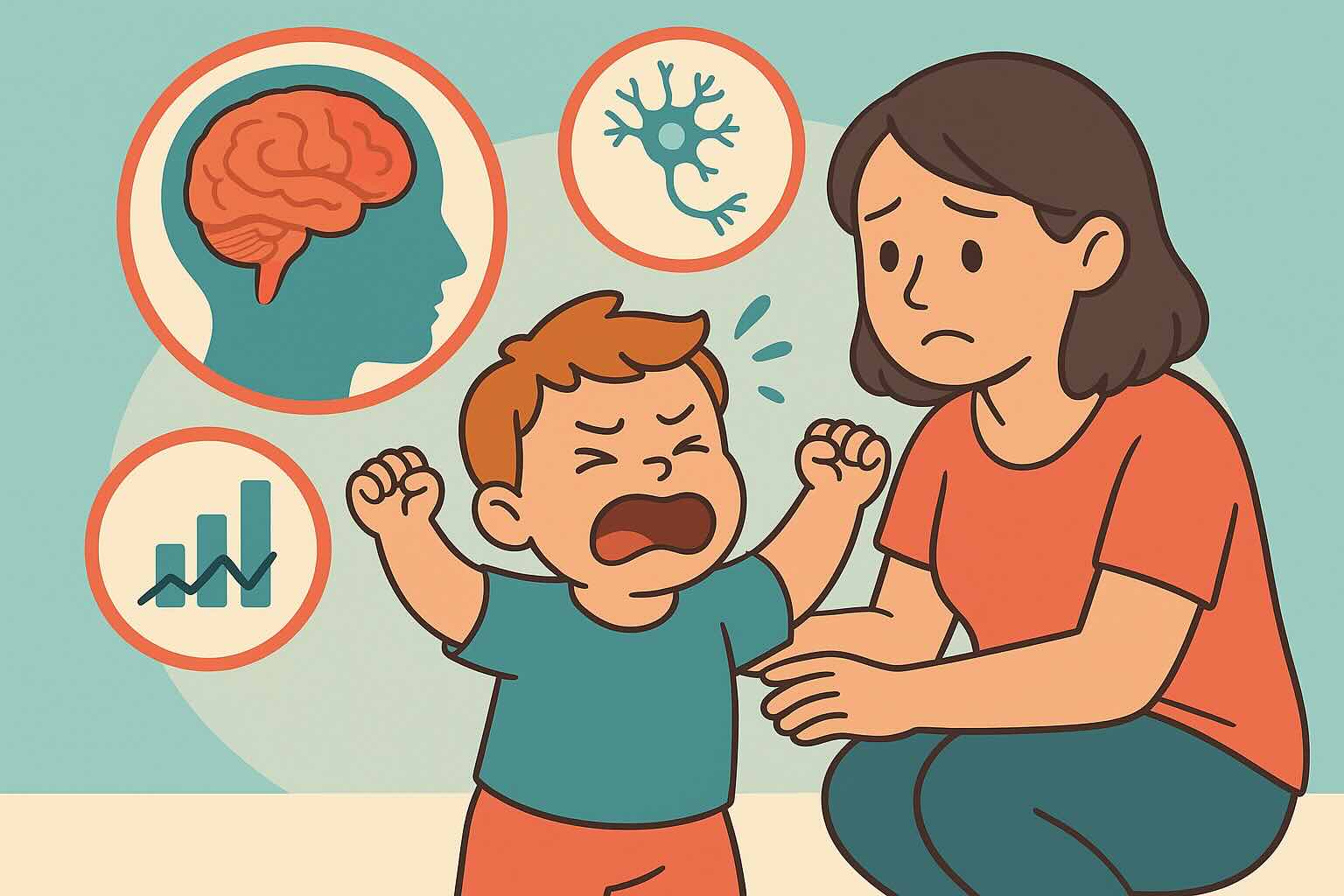Toddler Tantrum Triggers: 15 Hidden Causes Parents Miss


Your 2-year-old seems fine one minute, then suddenly melts down over something seemingly trivial. You've checked the obvious—they're not hungry, tired, or hurt—yet the tantrum still happens. Research shows that 83-91% of toddlers experience regular tantrums, but many parents miss the subtle triggers that actually cause these emotional storms.
This comprehensive guide reveals the 15 most commonly overlooked tantrum triggers based on recent child development research. Understanding these hidden causes can help you prevent up to 70% of tantrums before they start, transforming your daily routine from chaos to calm.
For immediate tantrum management, also check our complete response guide and public tantrum strategies. To understand the developmental science behind these triggers, our tantrum science guide explains how toddler brains process stress and overwhelm.
What You'll Learn About Hidden Tantrum Triggers
- Sensory Processing Issues - Why 16% of children have undiagnosed sensory triggers
- Physical and Medical Causes - Hidden discomfort that builds throughout the day
- Developmental Patterns - How brain growth spurts increase emotional reactivity
- Environmental Factors - Subtle changes that overwhelm developing nervous systems
- The Trigger Tracking System - A proven method to identify your child's specific patterns
- Age-Specific Prevention - Tailored strategies for 18 months to 4 years
- When Triggers Signal Bigger Issues - Red flags that warrant professional consultation
Estimated reading time: 9 minutes
Understanding Why Toddlers Have Hidden Triggers
Your Toddler's Developing Nervous System
Unlike adults, toddlers lack the neurological infrastructure to process multiple stressors simultaneously. Their developing nervous system operates like a cup that slowly fills throughout the day—each small stress adds a few drops until the cup overflows in what appears to be a sudden, unprovoked tantrum.
The science behind trigger accumulation:
- Toddler brains process sensory information 40% less efficiently than adult brains
- Stress hormones remain elevated 3x longer in young children
- Multiple small triggers create a cumulative effect leading to emotional overwhelm
- The prefrontal cortex (emotional regulation center) won't fully develop until age 25
The 15 Hidden Tantrum Triggers Parents Miss
Sensory Processing Triggers
1. Sensory Overload and Underload
What it looks like: Your child becomes aggressive in busy environments or seeks intense stimulation by spinning, jumping, or making loud noises.
The science: Up to 16% of children have sensory processing differences that are often misinterpreted as behavioral problems. Some children are hypersensitive (overwhelmed by normal stimuli) while others are hyposensitive (needing more intense input to feel regulated).
Prevention strategies:
- Create "sensory breaks" every 30-45 minutes in stimulating environments
- Provide a quiet retreat space with soft lighting and comfortable textures
- For sensory seekers: offer appropriate outlets like trampolines, crash pads, or chewy toys
- Watch for early warning signs: increased fidgeting, covering ears, or seeking tight hugs
2. Clothing and Texture Sensitivities
What it looks like: Meltdowns during dressing, constant pulling at clothes, or refusal to wear certain fabrics.
The research: Tactile defensiveness affects about 1 in 6 children, causing genuine physical discomfort from tags, seams, or fabric textures. This creates constant low-level irritation that reduces emotional regulation capacity.
Prevention strategies:
- Remove tags from all clothing or buy tagless options
- Choose soft, seamless clothing made from natural fibers
- Let your child help select clothes based on how they feel
- Gradually introduce new textures during calm moments
3. Temperature Regulation Issues
What it looks like: Tantrums when transitioning between indoor/outdoor temperatures or difficulty settling after physical activity.
The science: Toddlers have immature thermoregulation systems and may not recognize or communicate temperature discomfort before it becomes overwhelming.
Prevention strategies:
- Check room temperature regularly (ideal: 68-72°F)
- Layer clothing for easy adjustments
- Offer cooling/warming comfort items (cold washcloth, warm bath)
- Monitor for sweating or shivering as early warning signs
Physical and Medical Triggers
4. Blood Sugar Fluctuations (The "Hangry" Effect)
What it looks like: Sudden mood changes 30-60 minutes before obvious hunger signs appear.
The research: Blood sugar drops trigger cortisol and adrenaline release, causing temporary aggression and reduced emotional regulation 30-60 minutes before children show obvious hunger signs. This "hangry" state is particularly pronounced in toddlers due to their faster metabolism.
Prevention strategies:
- Offer protein-rich snacks every 2-3 hours
- Keep emergency snacks readily available (nuts, cheese, fruit)
- Watch for subtle early signs: increased whining, loss of focus, or seeking comfort items
- Avoid sugary snacks that cause blood sugar spikes and crashes
5. Dehydration Effects
What it looks like: Increased irritability during hot weather, after active play, or in the afternoon.
The science: Even mild dehydration (2% body water loss) significantly impacts concentration and emotional regulation in children. Toddlers are more susceptible because they have higher water turnover rates and may not recognize thirst signals.
Prevention strategies:
- Offer water every 30 minutes during active play
- Monitor urine color (pale yellow is ideal)
- Increase water intake during illness, hot weather, or travel
- Make water appealing with special cups or fruit infusions
6. Hidden Medical Discomfort
What it looks like: Unexplained behavioral changes, sleep disruptions, or increased tantrums without obvious triggers.
The research: Ear infections, teething pain, constipation, and allergies often present as behavioral issues before physical symptoms become obvious. Chronic low-level discomfort reduces coping capacity by up to 40%.
Prevention strategies:
- Track patterns alongside health symptoms
- Monitor for subtle signs: ear tugging, changes in eating/sleeping, unusual clinginess
- Consult healthcare providers about behavioral changes
- Consider food sensitivities if tantrums correlate with meals
7. Sleep Debt Accumulation
What it looks like: Tantrums that worsen throughout the week or increase during busy periods.
The science: Even 30 minutes of lost sleep per night accumulates into significant "sleep debt" that reduces emotional regulation capacity. Research shows fatigue-related tantrums peak in late afternoon/evening when cortisol levels naturally decline.
Prevention strategies:
- Maintain consistent bedtimes within 15 minutes nightly
- Watch for early tired signs: eye rubbing, yawning, decreased coordination
- Protect nap times during developmental transitions
- Consider earlier bedtimes during growth spurts or stressful periods
Developmental Triggers
8. Developmental Leap Periods
What it looks like: Sudden increase in tantrums during specific age periods: 18 months, 2 years, and 3-4 years.
The research: Rapid brain development periods cause temporary behavioral regression as neural pathways reorganize. During these "leaps," children's brains are working overtime to process new skills, leaving less capacity for emotional regulation.
Common leap periods:
- 18 months: Understanding of sequences and programs
- 2 years: Categorical thinking and sorting
- 3-4 years: Complex problem-solving and relationships
Prevention strategies:
- Expect temporary increases in tantrums during leap periods
- Provide extra support and patience during these phases
- Maintain routines to provide stability during brain reorganization
- Celebrate new skills as they emerge
9. Language Development Frustration
What it looks like: Intense tantrums when unable to communicate needs or wants, especially in children with limited vocabulary.
The research: Studies show toddlers with fewer spoken words demonstrate more severe tantrums. The gap between understanding (receptive language) and expression (expressive language) creates significant frustration as children know what they want but can't communicate it effectively.
Prevention strategies:
- Use visual aids, picture cards, or simple sign language
- Acknowledge their attempts to communicate: "You're trying to tell me something important"
- Teach key emotion words: mad, sad, scared, frustrated
- Avoid rushing or finishing their sentences
10. Autonomy vs. Capability Mismatch
What it looks like: Tantrums when prevented from doing tasks independently or when unable to complete desired actions.
The science: The desire for independence typically exceeds actual abilities by 6-12 months during the toddler years. This creates significant frustration when children can envision what they want to do but lack the motor skills or cognitive ability to complete tasks.
Prevention strategies:
- Break complex tasks into manageable steps
- Offer "help without taking over": hold the cup while they pour
- Create "yes spaces" where they can practice independence safely
- Validate their desire: "You really want to do that yourself"
Environmental and Routine Triggers
11. Routine Disruptions and Transitions
What it looks like: Meltdowns during schedule changes, travel, or unexpected events.
The research: Toddlers rely on predictability for neurological security. Unexpected changes activate their stress response system, making emotional regulation significantly more difficult. Even positive changes (fun outings) can be overwhelming.
Prevention strategies:
- Give 5-10 minute warnings before transitions
- Use visual schedules to show the day's activities
- Prepare for changes by discussing them in advance
- Maintain key routines (bedtime, meals) even during disruptions
12. Screen Time Emotional Dysregulation
What it looks like: Intense tantrums when screen time ends or during "screen-free" periods.
The research: 2023 research shows children using screens for emotional regulation have 1.5x more intense tantrums when screens are removed. This creates a problematic cycle where children become dependent on screens for mood regulation.
Prevention strategies:
- Establish clear screen time boundaries with visual timers
- Provide transition warnings: "5 more minutes, then we read books"
- Offer alternative calming activities: music, sensory bins, quiet play
- Avoid using screens to stop tantrums (reinforces the cycle)
13. Overstimulation and Understimulation
What it looks like: Tantrums in busy environments OR attention-seeking behaviors when bored.
The science: Both too much and too little stimulation can trigger tantrums. Overstimulation overwhelms developing nervous systems, while understimulation leads to frustration and attention-seeking behaviors.
Signs of overstimulation:
- Increased activity or aggression
- Covering ears or eyes
- Seeking quiet spaces or comfort items
Signs of understimulation:
- Destructive behavior
- Constant requests for attention
- Restlessness or hyperactivity
Prevention strategies:
- Monitor stimulation levels throughout the day
- Provide "sensory breaks" in quiet spaces
- Rotate toys to maintain novelty
- Balance active and calm activities
Social and Emotional Triggers
14. Social Overload and Peer Pressure
What it looks like: Tantrums after social events, playgroups, or when multiple people are present.
The research: Some children become overwhelmed by group dynamics, social expectations, or prolonged social interaction. Their nervous systems need recovery time after intense social experiences.
Prevention strategies:
- Limit social activities to 1-2 hours for sensitive children
- Provide quiet time after social events
- Teach simple social scripts: "I need a break"
- Watch for signs of social fatigue: increased clinginess or withdrawal
15. Emotional Overwhelm (Positive and Negative)
What it looks like: Tantrums during exciting events (birthdays, holidays) or after emotional experiences.
The science: Both positive and negative intense emotions can exceed toddler coping capacity. The nervous system responds similarly to excitement and stress, both requiring emotional regulation skills that toddlers are still developing.
Prevention strategies:
- Prepare for big emotions during exciting events
- Validate all emotions: "That was so exciting, your body has big feelings"
- Provide calm-down time after intense experiences
- Teach simple coping strategies: deep breathing, hugging a comfort item
Age-Specific Trigger Patterns
18-Month-Olds: The Communication Crisis
Primary triggers: Language frustration, sensory overwhelm, sleep transitions Peak tantrum frequency: Beginning of daily tantrums for 20% of children Key prevention: Focus on alternative communication methods and consistent routines
2-Year-Olds: The Independence Struggle
Primary triggers: Autonomy mismatches, routine changes, social expectations Peak tantrum frequency: 87% experiencing regular tantrums Key prevention: Offer appropriate choices and maintain clear boundaries
3-4-Year-Olds: The Emotional Complexity Phase
Primary triggers: Social pressures, complex emotional situations, developmental expectations Peak tantrum frequency: Beginning to decline but still affecting 60% of children Key prevention: Teach emotion vocabulary and coping strategies
The Trigger Tracking System: A Proven Prevention Method
How to Identify Your Child's Unique Patterns
Week 1-2: Basic Tracking Keep a simple log noting:
- Time of tantrum
- Duration and intensity (1-10 scale)
- Activities in the 2 hours prior
- Basic needs status (hunger, thirst, sleep, comfort)
Week 3-4: Environmental Tracking Add detailed observations:
- Sensory environment (noise, lighting, crowds)
- Temperature and clothing comfort
- Screen time and transitions
- Social interactions and stimulation levels
Week 5-6: Pattern Analysis Look for correlations:
- Time-of-day patterns
- Specific environmental triggers
- Cumulative stress factors
- Individual sensitivities
Digital Tracking Tools
- Simple smartphone apps for quick logging
- Photo documentation of triggers
- Voice memos for detailed observations
- Share tracking data with caregivers for consistency
When Hidden Triggers Signal Bigger Issues
Normal Trigger Responses vs. Concerning Patterns
Normal responses to triggers:
- Tantrums that improve with trigger management
- Gradual learning and adaptation over time
- Response to comfort and redirection
- Correlation between triggers and reactions
Concerning patterns requiring professional evaluation:
- No identifiable triggers despite careful tracking
- Extreme reactions to minor triggers
- Multiple severe tantrums daily (>5 per day)
- Self-harm or aggressive behavior toward others
- Inability to recover from tantrums without extensive intervention
- Regression in previously acquired skills
- Tantrums lasting longer than 15 minutes regularly
When to Seek Professional Help
Occupational Therapy evaluation for:
- Persistent sensory processing issues
- Extreme clothing or texture sensitivities
- Difficulty with motor planning and coordination
- Struggles with transitions and routine changes
Pediatric consultation for:
- Suspected medical causes (sleep disorders, allergies, nutritional issues)
- Developmental concerns or delays
- Behavioral changes that don't respond to interventions
Child psychology evaluation for:
- Severe aggression or self-harm
- Extreme anxiety or mood changes
- Social difficulties affecting daily functioning
- Family stress significantly impacted by child's behavior
Creating Your Personalized Prevention Plan
Step 1: Identify Your Top 3 Triggers (Week 1-2)
Based on your tracking, focus on the most frequent triggers affecting your child. Common combinations include:
- Hunger + overstimulation
- Fatigue + routine changes
- Sensory overwhelm + social pressure
Step 2: Implement Targeted Strategies (Week 3-4)
Choose 2-3 specific prevention strategies for each identified trigger:
- Environmental modifications
- Routine adjustments
- Teaching coping skills
- Meeting physical needs proactively
Step 3: Monitor and Adjust (Week 5-6)
Track improvement and refine strategies:
- Note reduction in tantrum frequency and intensity
- Adjust strategies based on what works
- Celebrate progress and identify remaining challenges
Step 4: Maintain Long-Term Success (Ongoing)
- Regular check-ins on trigger patterns
- Adjust strategies as your child develops
- Prepare for developmental transitions
- Share successful strategies with other caregivers
Real Parent Success Stories
Maria's Story: Sensory Solutions
"My 2-year-old had daily meltdowns that I couldn't understand. After tracking for two weeks, I realized they always happened in bright, noisy environments. We started bringing noise-canceling headphones to the grocery store and taking 'quiet breaks' during outings. Within a month, his tantrums decreased by 80%. Now I can see his sensory overload signs before they become overwhelming."
David's Story: Blood Sugar Management
"My daughter seemed to have tantrums out of nowhere, but tracking revealed they happened exactly 45 minutes after meals. I realized she was having blood sugar crashes. We switched to protein-rich snacks every 2 hours and kept emergency snacks in the car. The improvement was dramatic—from 3-4 tantrums daily to maybe one per week."
Lisa's Story: Developmental Understanding
"During my son's 18-month developmental leap, tantrums skyrocketed. Instead of trying to stop them, I focused on extra comfort and maintaining routines. Understanding that his brain was growing helped me stay patient. After 3 weeks, the intense period passed, and he emerged with amazing new language skills."
Your 30-Day Trigger Prevention Challenge
Week 1: Discovery Phase
- Start basic trigger tracking
- Focus on physical needs (hunger, thirst, fatigue, comfort)
- Notice time-of-day patterns
- Begin 5-minute transition warnings
Week 2: Environmental Awareness
- Add sensory environment tracking
- Modify overstimulating spaces
- Create calm-down areas
- Monitor screen time effects
Week 3: Developmental Support
- Research current developmental phase
- Adjust expectations during leaps
- Increase language support
- Provide appropriate independence opportunities
Week 4: Integration and Refinement
- Analyze patterns from first 3 weeks
- Implement top 3 most effective strategies
- Share insights with other caregivers
- Plan for ongoing trigger management
The Science of Long-Term Benefits
Research shows that children whose triggers are identified and managed develop:
- Stronger emotional regulation skills by age 5
- Better stress management throughout childhood
- Improved social relationships due to fewer behavioral challenges
- Enhanced learning capacity when not overwhelmed by triggers
- Increased self-awareness of their own needs and limits
Family benefits include:
- 60-70% reduction in daily stress levels
- Improved parent-child relationships
- Greater confidence in handling challenging behaviors
- More enjoyable family outings and activities
Key Takeaways: Your Trigger Prevention Toolkit
- ✅ 83-91% of toddlers have tantrums, but most triggers are preventable
- ✅ Hidden triggers accumulate throughout the day like drops in a cup
- ✅ Sensory, physical, and developmental factors cause 70% of "mysterious" tantrums
- ✅ Tracking for 2-3 weeks reveals patterns most parents miss
- ✅ Age-specific approaches are more effective than one-size-fits-all strategies
- ✅ Prevention is 5x more effective than reaction-based management
- ✅ Environmental modifications can reduce tantrums by 40-60%
- ✅ Professional help is available for persistent or concerning patterns
- ✅ Long-term benefits extend far beyond the toddler years
Remember: You're not preventing all tantrums—you're preventing the unnecessary ones caused by triggers you can control. This leaves energy for helping your child learn emotional regulation during the tantrums that truly are about big feelings.
For effective communication during the tantrums that do occur, our tantrum communication scripts guide provides age-appropriate phrases that help during meltdowns. If bedtime tantrums are a particular challenge, our night tantrums guide addresses evening-specific triggers like circadian rhythm disruption and overstimulation.
This article is based on peer-reviewed research in child development, sensory processing, and pediatric psychology. Individual experiences vary significantly based on child temperament, family circumstances, and implementation consistency. Always consult with your pediatrician if you have concerns about your child's emotional development or behavior patterns.
Challenging Moments Support
Access step-by-step parenting strategies, quick tips, and age-specific guidance for difficult situations when you need it most.

Free Tantrum Scripts
Help your toddler manage big emotions with these strategies and scripts.
Frequently Asked Questions
Download RootWise Today
Need personalized support?
RootWise's AI coach can provide tailored strategies for your specific situation, available 24/7 when you need it most.
Learn More About AI Coaching →

